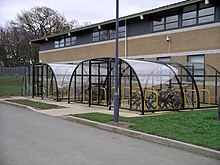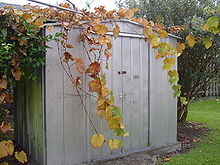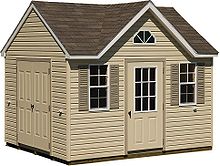Shed


A shed is typically a simple, single-story structure in a back garden or on an allotment that is used for storage, hobbies, or as a workshop. The modern Oxford English Dictionary (OED) defines sheds as a "slight structure built for shelter or storage, or for use as a workshop, either a separate building or attached to a permanent building as a lean-to; often with open front or sides."[1]
Sheds vary considerably in the complexity of their construction and their size, from small open-sided tin-roofed structures to large wood-framed sheds with shingled roofs, windows, and electrical outlets. Sheds used on farms or in industry can be large structures.
Types
Small domestic sheds
The simplest, least expensive sheds are available in kit form. Both shed kits and "do-it-yourself" plans are available for wooden sheds. Sheds are used to store home and garden tools and equipment such as push lawn mowers, lawn tractors, and gardening supplies. In addition, sheds can be used to store items or products that are not suitable for indoor storage, such as gasoline, pesticides, or herbicides.

For homes with small gardens or modest storage needs, there are several types of very small sheds. These include corner sheds, which fit into a corner (3’ tall x 3’ wide x 2’ deep), vertical sheds (5’ tall x 3’ wide x 4’ deep), horizontal sheds (3’ tall x 5’ wide x 4’ deep), and toolsheds. When a shed is used for tool storage, shelves and hooks are often used to maximize the storage space. Gambrel-style roofed sheds, which resemble a Dutch-style barn have a high sloping roofline which increases storage space in the 'loft'. Another style of small shed is the saltbox-style shed.
Larger domestic sheds

Larger, more expensive sheds are typically constructed of wood and include features typically found in house construction, such as windows, a shingled roof, and electrical outlets. Larger sheds provide more space for engaging in hobbies such as gardening, small engine repair, or tinkering.
Some sheds have small porches or include furniture, which allows them to be used for relaxation purposes. In some cases, teleworkers and homeworkers in general who live in mild climates use small- to medium-sized wooden garden sheds as outdoor offices. There is a growing industry in providing "off the peg" garden offices to cater for this demand, particularly in the UK but also in the US.
Shed owners can customize wooden sheds to match the features (e.g., siding, trim, etc.) of the main house. A number of decorative options can be added to sheds, such as dormers, shutters, flowerboxes, finials, and weathervanes. As well, practical options can be added such as benches, ramps, ventilation systems (e.g., in cases where a swimming pool heater is installed in a shed), and electric lighting. Sheds designed for gardening, called "potting sheds", often feature windows or skylights for illumination, ventilation grilles, and a potter's bench for mixing soil and re-potting plants.
Specific-use sheds
- Bike sheds (also called bicycle sheds) usually contain a framework on which bikes can be supported and locked. Bike sheds range from little more than a supported roof to more complex structures with walls and locking doors.
- Boat sheds (also called boatsheds) are lockable wooden sheds built near a body of water to store small private boats, bathing suits, and related items. Boat sheds used for rowing clubs are large structures for storing skiffs.
- Agricultural sheds

A hay shed typical of Australia and New Zealand (otherwise known as a barn) - Farm sheds and other outbuildings are used to store farm equipment, tractors, tools, hay, and supplies, or to house horses, cattle, poultry or other farm animals. Run-in sheds are three-sided structures with an open face used for horses and cattle.
- Shearing sheds can be large sheds found on sheep stations to accommodate large-scale sheep shearing.
- Railway sheds
- Engine sheds are structures used for the maintenance or storage of railway locomotives. In Britain these are also called Motive Power Depots.
- Goods sheds are railway buildings designed for storing goods before or after carriage in a train.
- Train sheds are buildings adjacent to a railway station where the tracks and platforms are covered by a roof. The first train shed was built in 1830 at Liverpool's Crown Street Station.
- Snow sheds are strongly-built timber or reinforced concrete tunnels that protect railroad tracks (or roads) from avalanches.
- Miscellaneous sheds
Construction
The main types of shed construction are metal sheathing over a metal frame, plastic sheathing and frame, all-wood construction, and vinyl-sided sheds built over a wooden frame. Each type has various advantages and disadvantages that a homeowner has to consider. For example, while metal sheds are fire and termite-resistant, they can rust over time, or be severely damaged by high winds. The International Building Code(IBC) defines a shed as a building or structure of an accessory character; it classifies them under Utility and Miscellaneous Group U (Chapter 3 Section 312).
Metal sheds

Metal sheds made from thin sheet metal sheathing (galvanized steel, aluminium, or corrugated iron) attached to a metal frame. Metal sheds are a good choice when long-term strength and resistance to fire, rot, or termites is desired. However, metal sheds may rust over time, particularly if they are constructed from steel that is not galvanized.
As well, some types of metal sheds that have thin walls are easily dented, which may makes some types of thin metal sheds a poor choice for vandal-prone areas or for high-traffic activities such as small businesses. In cold climates, metal sheds with thin walls need to have snow and ice cleared from the roof, because the thin metal may be damaged by a heavy accumulation. Since thin metal sheds weigh much less than wood or PVC plastic sheds, thin metal sheds are more at risk of being damaged by heavy winds. To prevent wind damage, thin metal sheds should be attached to a concrete foundation with screws.
Plastic sheds
Plastic shed kits utilizing heavy molded plastics such as PVC and polyethylene are less expensive than sheet metal sheds. PVC resins and high-impact, UV light-resistant polyethylene make plastic outdoor sheds stronger, lighter, and more durable and more resistant to denting and chipping than wood, and tend to be more stable.
Plastic shed kits sided with vinyl are typically among the least expensive types of shed construction. Higher-quality sheds use UV-resistant plastic and powder-coated metal frames. Many plastic sheds are modular to allow for easy extensions, peg-boards, shelving, attic-storage, windows, skylights, and other accessories to be added later.
Plastic sheds are not susceptible to termite and wood-boring insect damage, and they require little maintenance. Being rot-proof they don't need preservative applied.
Wooden sheds

Wooden sheds have a natural look that can blend in well with garden environments. Despite the strength of wood, over time it can rot, split, warp or become susceptible to mold and mildew, so wood sheds should be treated for protection. Wood sheds need regular maintenance, such as keeping plant matter and debris from piling up beside the walls and on the roof, and occasional rot-proofing with preservative. Sheds are sometimes also re-stained or varnished at times for aesthetic reasons. Fire, and in some countries termite attack, are also potential problems.
Stains and preservatives can be applied to wood sheds to prevent damage to the wood caused by exposure to rain, damp ground, UV light, harsh climatic conditions, fungal attack and wood-boring insects. If a colored preservative oil or stain is used, a wooden shed can either be made to stand out as a feature within a garden, or to blend in with its surroundings. Red cedar coloured stain is popular. Some types of wood, such as cedar, are more naturally-resistant to water damage. One advantage of using wood sheds is that it is easier to modify wooden sheds (i.e., than metal sheds) by adding windows, doors, shelving, exterior trim etc, because wood can be cut and drilled using commonly-available tools. Some homeowners may prefer wood sheds because wood is a renewable resource.
Vinyl-sided sheds

Vinyl-sided sheds are typically built with standard wood framing construction and oriented strand board (OSB) on the walls covered with standard vinyl siding. Vinyl-sided sheds never need to be painted, they are generally stronger than plastic or metal sheds, and are usually built to conform with the local building codes. They are not eco-friendly and they cost more than wooden, metal or plastic sheds.
Culture
In Australia and New Zealand the term shed can be used to refer to any building that is not a residence and which may be open at the ends or sides, or both. Australia's passion for sheds is documented in Mark Thomson's Blokes and Sheds. Recently 'Men's Sheds' have become common in Australia.[3] In New Zealand, the bi-monthly magazine The Shed appeals to the culture of "blokes" who do woodwork or metalwork DIY projects in their sheds. There is also another magazine called The Shed, a bimonthly pdf magazine produced in the UK but with a global audience, for people who work (usually in creative industries) in garden offices, sheds and other shedlike atmospheres.
In the UK, men have long enjoyed working in their potting sheds; the slang term "sheddie", to refer to a person enamoured of shed-building, testifies to the place of sheds in UK popular culture. Author Gordon Thorburn examined this proclivity in his book Men and Sheds, which argues that a "place of retreat" is a "male necessity" which provides men with solace, especially during their retirement.
The first National Shed Week was held in the UK in July 2007 and received widespread coverage in the media, the winning shed was a normal one converted into a Roman Temple.
National Shed Week in 2008, was another great success with Shed of the year winner being a hand built octagonal Pub Shed.
The third annual shed week and Shed of the year 2009 will take part in July 2009.
The UK Internet usenet group uk.rec.sheds is a forum for discussing shed construction.
Etymology
The word is recorded in English since 1481, as shadde, possibly a variant of shade. The word shade comes from the Old English word "sceadu", which means "shade, shadow, darkness." The term's P.Gmc. cognate, "skadwo" also means "shady place, protection from glare or heat."[4]
The Old English word is spelled in different ways, such as shadde, shad or shedde, all of which come from an "Old Teutonic/Anglo-Saxon root word for separation or division." The first attested usage of the word, in 1481, was in the sentence "A yearde in whiche was a shadde where in were six grete dogges." The Anglo Saxon word "shud", which means "cover" may also have been part of the development of the word. In 1440, a "shud" was defined as a "... schudde, hovel, swyne kote or howse of sympyl hyllynge [covering] to kepe yn beestys."[1]
See also

Other meanings
The term "shed" can also refer to the shed style of modern architecture.
References
- ^ a b The History of Storage Sheds - Lancaster County Barns
- ^ RAPark_HomePage
- ^ "The Men's Shed Story". Archived from the original on 2008-12-18.
- ^ Online Etymology Dictionary
Sources
- This article incorporates text from a publication now in the public domain: Chisholm, Hugh, ed. (1911). Encyclopædia Britannica (11th ed.). Cambridge University Press.
{{cite encyclopedia}}: Missing or empty|title=(help) - Gordon Thorburn, Men and Sheds, ISBN 1-84330-329-9
External links
- www.readersheds.co.uk Add your shed and it could be Shed of the year 2009 view other sheddie's sheds.
- shedblog.co.uka blog about sheds
- [1] How to build a outdoor shed with step by step guide and illustrations
- geekbooks.com sheds and barns Backyard shed and barn resources for the do-it-yourselfer.
- Shedworking blog The online blog version of the electronic lifestyle magazine for shedworkers The Shed
- The Shed A bi-monthly magazine for DIY blokes and sheddies -- projects and general articles.
- The garages of Murmansk, BBC News

